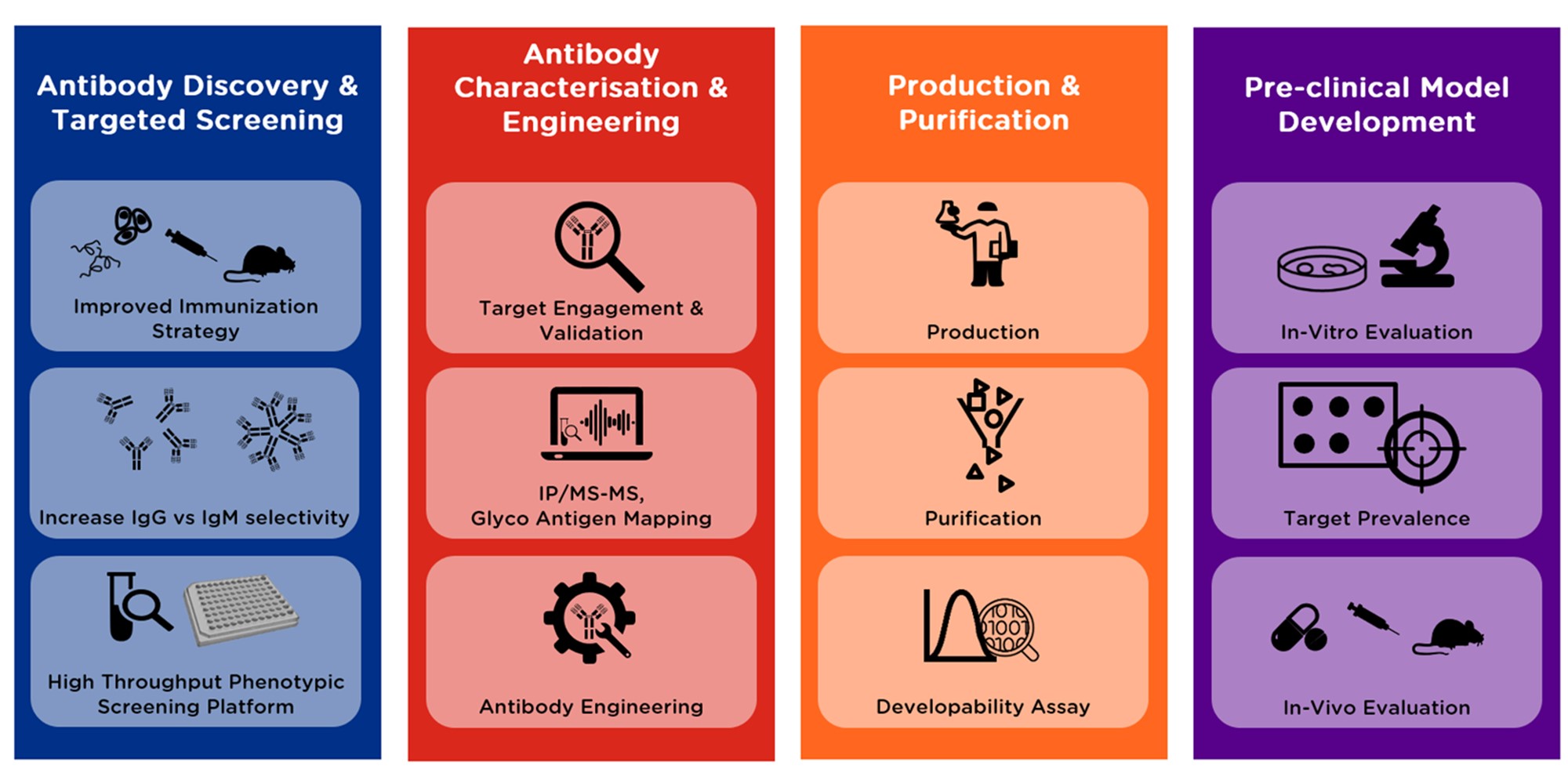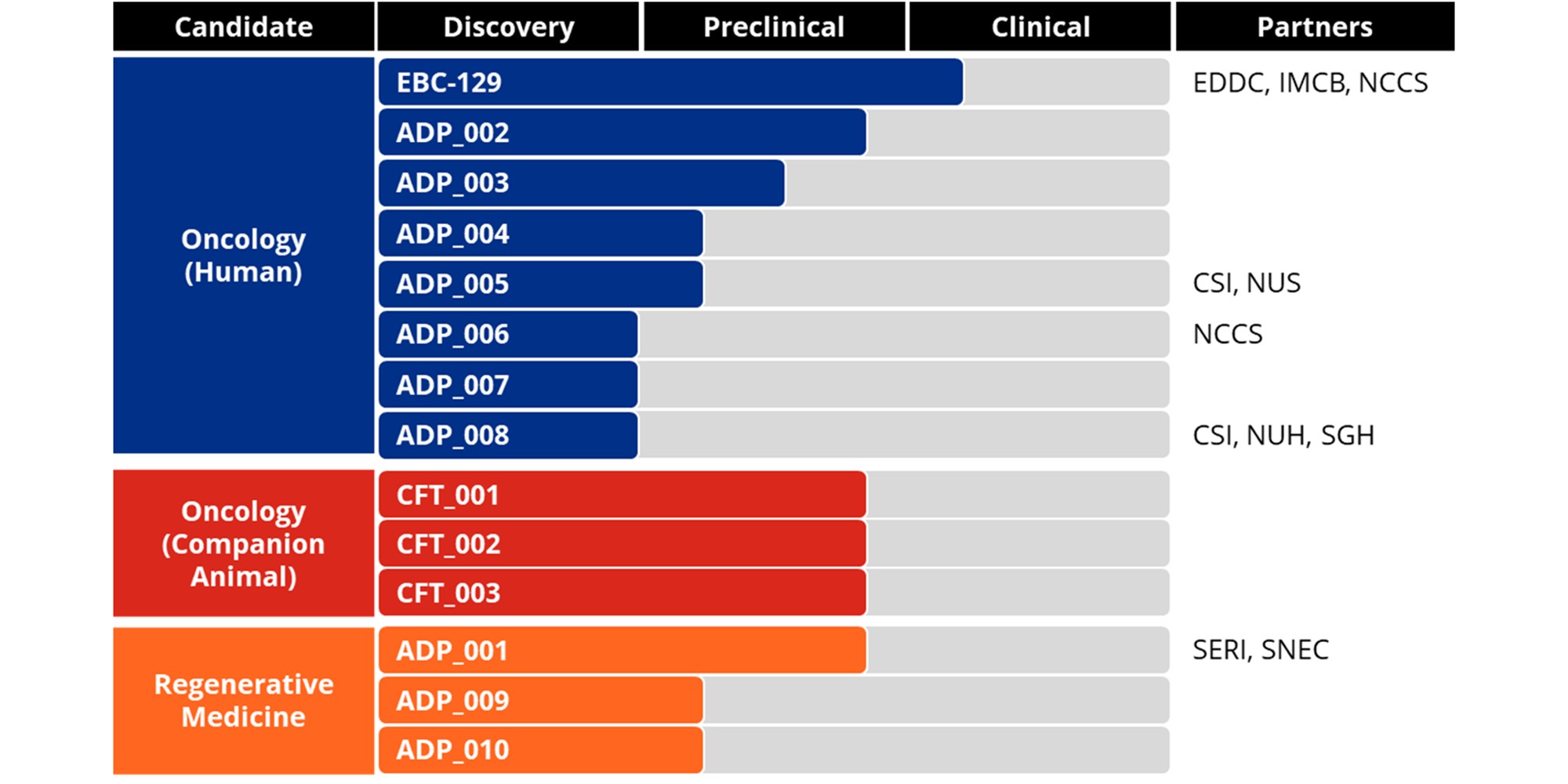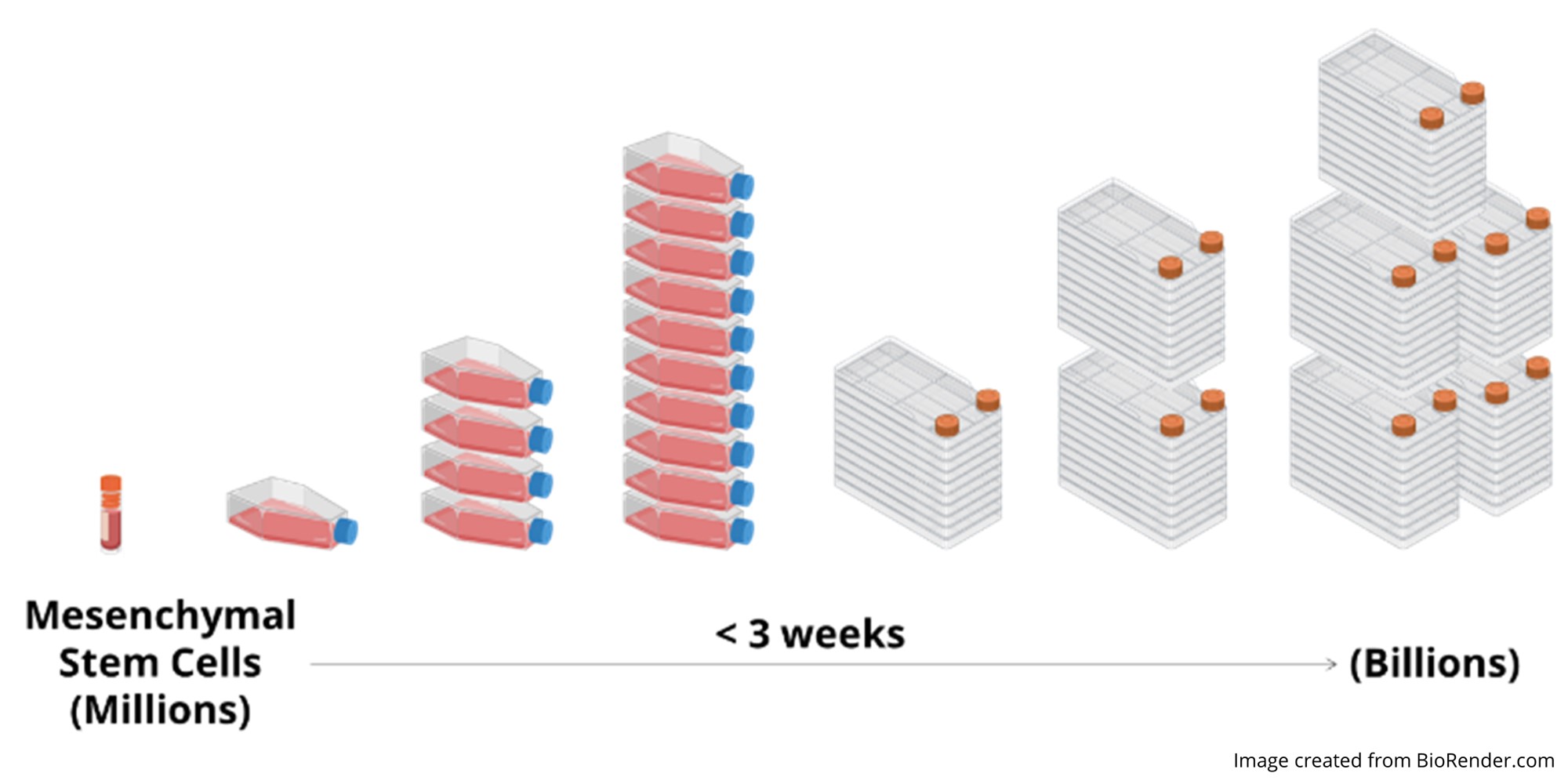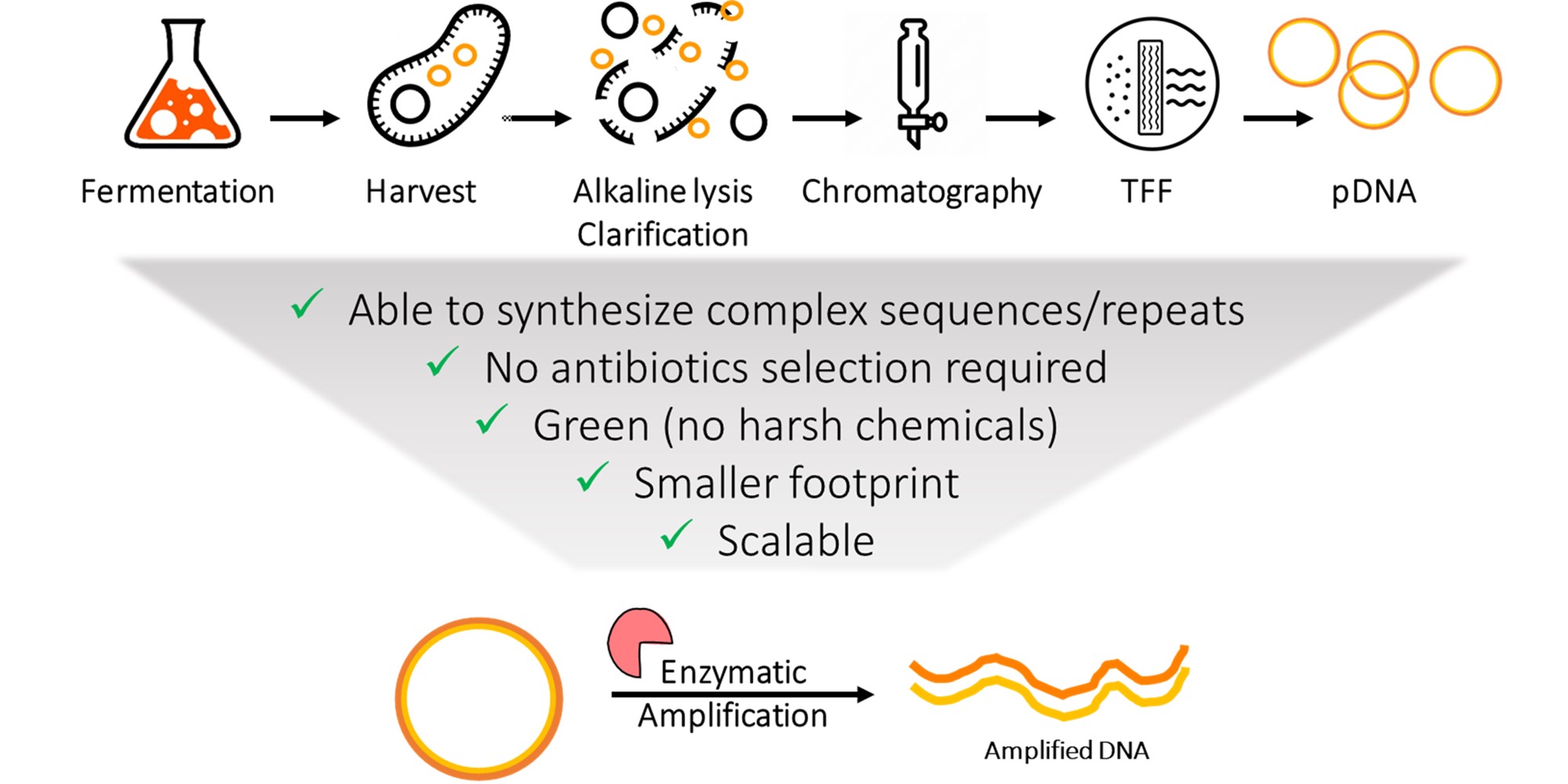ANTIBODY DEVELOPMENT PLATFORM
Target-agnostic monoclonal antibodies generation using robust hybridoma technology and adopts a high-throughout phenotypic screening approach. Our platform enabled the discovery of antibodies against unique conformational epitopes and post-translational modifications (e.g. glycosylation) particular to the cell type of interest, imparting an additional level of specificity and improving therapeutic index of the candidate antibodies.

- Advantageous positioning: Access to value chain of bioprocessing capabilities within the institute
- Antibody specificity: Binding epitopes (conformational and glycosylation) unique to cell type of interest
- Robust immunisation strategy: Able to generate monoclonal antibodies against cells or protein
- Antibody engineering: Able to evaluate different modalities for the antibody candidate (naked, ADC, CAR-T, multi-specific)
- Assay development: Cell-based assay development for functional evaluation
Pipeline

EXTRACELLUAR VESICLES MANUFACTURING PLATFORM
We have over 15 years of experience in the robust scale-up of therapeutic extracellular vesicles (EVs) from laboratory to GMP. The therapeutic EVs produced have shown reproducible efficacy in various preclinical studies. We have also successfully completed early-phase clinical trials using GMP-compliant human mesenchymal stem cell EVs.

- GMP-compliant production to support bench to early-phase clinical trial
- Enrichment process of extracellular vesicles
- Process development to adapt scale-up to bioreactors
CELL-FREE NUCLEIC ACID SYNTHESIS

- Scalable and cost-effective method to amplify nucleic acids
- Robust platform with capabilities to synthesize complex sequences and repeats
- Smaller footprint to save space as compared to traditional methods
- Environmentally friendly as no harsh chemicals are used in the process
OUR TRACK RECORD
Significant Milestones:
- EBC-129, a pan-cancer antibody-drug conjugate, approved for clinical trial in 2023 (Press Release)
- Produced GMP-compliant extracellular vesicles for use in early-phase clinical trials in 2022
- Our platform enabled the discovery of antibodies against unique conformational epitopes on stem cells and cancer cells, which can be engineered into various modalities
Featured Publications:
- Mario Gimona, Maria Felice Brizzi, Andre Boon Hwa Choo, Massimo Dominici, Sean M. Davidson, Johannes Grillari, Dirk M. Hermann, Andrew F. Hill, Dominique de Kleijn, Ruenn Chai Lai, Charles P. Lai, Rebecca Lim, Marta Monguió-Tortajada, Maurizio Muraca, Takahiro Ochiya, Luis A. Ortiz, Wei Seong Toh, Yong Weon Yi, Kenneth W. Witwer, Bernd Giebel and Sai Kiang Lim (2021) Critical considerations for the development of potency tests for therapeutic applications of mesenchymal stromal cell-derived small extracellular vesicles. Cytotherapy 23(5): 373-380
- Bin Zhang, Ruenn Chai Lai, Wei Kian Sim, Andre Boon Hwa Choo, Ellen Birgit Lane and Sai Kiang Lim (2021) Topical Application of Mesenchymal Stem Cell Exosomes Alleviates the Imiquimod Induced Psoriasis-Like Inflammation. International Journal of Molecular Science 22(2):720
- Leonard Leong, Heng Liang Tan, Simeon Cua, Kylie Su Mei Yong, Qingfeng Chen and Andre Choo (2020) Preclinical Activity of Embryonic Annexin A2-Specific Chimeric Antigen Receptor T Cells Against Ovarian Cancer. International Journal of Molecular Sciences 21(2): 381
- Heng Liang Tan, Charlene Yong, Bao Zhu Tan, Wey Jia Fong, Jayanthi Padmanabhan, Angela Chin, Vanessa Ding, Ally Lau, Lu Zheng, Xuezhi Bi, Yuansheng Yang and Andre Choo (2018) Conservation of oncofetal antigens on human embryonic stem cells enables discovery of monoclonal antibodies against cancer. Scientific Reports 8(1): 11608
- Hau Wan Leung, Asja T Moerkamp, Jayanthi Padmanabhan, Sze-Wai Ng, Marie-José Goumans and Andre Choo (2015) mAb C19 targets a novel surface marker for the isolation of human cardiac progenitor cells from human heart tissue and differentiated hESCs. Journal of Molecular and Cellular Cardiology 82: 228-37
- Heng Liang Tan, Wey Jia Fong, Eng Hin Lee, Miranda Yap and Andre Choo (2009) mAb 84, a cytotoxic antibody that kills undifferentiated human embryonic stem cells via oncosis. Stem Cells 27(8): 1792-801
Landmark Patent & IP:
- Anti-Ceacam6 Antibodies and Methods of Use (2022)
- Anti-Axl Tyrosine Kinase Receptor Antibodies And Uses Thereof (2022)
- Cytotoxic Antibody (2022)
- Anti-ERBB-2 Antibodies and Uses Thereof (2021)
- Anti Oligosaccharide Antibody (2021)
- Anti-Annexin A2 Monoclonal Antibodies (2020)
- Enrichment And Characterization Of Human Corneal Endothelial Cells (Hcenc) With Novel Monoclonal Antibody (2019)
- Use of Markers of Undifferentiated Pluripotent Stem Cell (2014)
The Team

Dr Andre Choo
andre_choo@bti.a-star.edu.sg
Deputy Executive Director
Senior Principal Scientist III
PhD in Biological Science (2002), University of Technology, Sydney, Australia
Research Focus / Interest
- Generation and characterization of novel anti-glycan mAbs to cell surface markers on stem cells, progenitor cells and cancer cells
- Development of a comprehensive Antibody Discovery Platform to move candidate mAbs from the bench to potential diagnostic and therapeutic applications
- Unravel the underlying mechanism of oncotic cell killing by mAbs
- Elucidating key signalling pathway and post-translation modifications in pluripotent stem cells and cancer cells and understanding its role in regulating cell fate
- Translating the therapeutic efficacy of MSC exosomes into a clinical application

Dr Zhang Huibin
zhang_huibin@bti.a-star.edu.sg
Principal Scientist I
PhD in Genetics (2012), Stanford University, USA
Research Focus / Interest
- Development of enzymatic (cell-free) approaches to synthesize nucleic acids
- Developing end-to-end nucleic acid manufacturing capabilities
- Synthetic biology & genetic circuit regulatory control
- Functional assay/high-throughput screen development

Dr Leung Hau Wan
leung_hau_wan@bti.a-star.edu.sg
Senior Scientist II
PhD in Stem Cell Biology (2014), National University of Singapore, Singapore
Research Focus / Interest
- Scale-up and differentiation of stem cells for therapeutic and industrial applications
- Generation and characterization of novel antibodies targeting cell surface markers (Antibody Discovery Platform)
- Biologics production in CHO cells
.png?sfvrsn=1a7df424_3)

